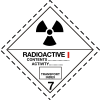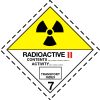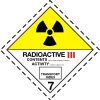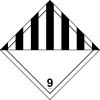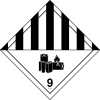Class of dangerous goods
The dangerous goods class (exact classes of dangerous goods , English classes of dangerous goods , imprecise and hazard class , class of danger ) is the classification of dangerous goods according to the danger for the transport as the United Nations have issued.
Basics
The handling of dangerous goods was stipulated by the United Nations in the Model Regulations of the UN Recommendations on the Transport of Dangerous Goods , which are currently valid in Revision 20 (2017). This also includes the structure of the dangerous goods classes.
They are divided into 9 classes. The further subdivision is a classification code ( classification code specified in more detail) depending on the class:
- The class 1 is in subclasses ( division number , indicates the level of danger) and compatibility groups ( compatibility group , makes statements about the mixed packing) divided
- Classes 2 to 9 via codes on degree of danger or substance properties ( subdivisions )
In addition, the packaging groups must be observed.
The dangerous goods classes have been incorporated into international agreements such as the European Agreement on the International Carriage of Dangerous Goods by Road (ADR), inland waterways (ADN, with ADNR and ADN-D), the international regulations for the carriage of dangerous goods by rail (RID) and for the Safety of Life at Sea (SOLAS) (referred to there as the International Maritime Dangerous Goods Code , IMDG), and are also used in a similar manner in road transport in the USA (tunnel restrictions imposed by the US DOT ). The dangerous goods classification is often found in American literature or in US imports as DOT class .
The German designations given here are those given by the German version of the current ADR that is valid for Austria and Germany.
To compare the hazard classes according to UN Rec.Transp. and UN-GHS see GHS hazard pictogram
Class 1 - Explosives
Explosives and articles containing explosives
Subclasses

|
|
Compatibility Groups
| description | |
|---|---|
| A. | Explosive |
| B. | Object with explosive and less than two effective safety devices (features) |
| C. | Fuel or other deflagrant explosive |
| D. | Detonating explosive or black powder |
| E. | Object with detonating explosive material without ignition means with propelling charge |
| F. | Article containing a detonating explosive with its own means of ignition, with or without a propelling charge |
| G | Pyrotechnic substance or object containing pyrotechnic substance |
| H | Article which both an explosive substance and white phosphorus containing |
| J | Article which both explosive and flammable liquid or flammable gel contains |
| K | Object that contains both an explosive substance and a toxic chemical agent |
| L. | Explosive substance or object containing an explosive substance which presents a particular risk and which requires separation of each individual type |
| N | Object that contains only extremely insensitive detonating substances |
| S. | Substance or object that is packaged or designed in such a way that any effect resulting from an unintended reaction is limited to the package |
Class 2 - gases and gaseous substances
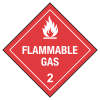
|

|

|
Pure gases, gas mixtures , mixtures of one or more gases with one or more other substances and articles containing such substances
Gases are substances that have a vapor pressure of more than 3 bar at 50 ° C or are completely gaseous at 20 ° C and 1013 mbar pressure. This class includes compressed (compressed), liquefied, or dissolved gases. |
Examples: propane gas , hydrogen , hairspray , acetylene , nitrous oxide
Capital letters are used to indicate the degree of danger. These capital letters are the first letters of the English name:
| Degree of danger | meaning | English |
|---|---|---|
| A. | suffocating | asphyxiant |
| O | oxidizing | oxidizing |
| F. | flammable | flammable |
| T | toxic | toxic |
| C. | corrosive | corrosive |
Class 3 - Flammable Liquids
Class 3 includes substances and objects that are liquid at 20 ° C and 1013 mbar, have a maximum vapor pressure of 3 bar at 50 ° C, are not completely gaseous at 20 ° C and 1013 mbar and have a flash point of no more than 60 ° C. Flammable liquids and molten solids with a flash point above 60 ° C that are heated to or above their flash point are also class 3 substances. Examples: gasoline , alcohol , certain liquefied metals.
- Classification codes
The properties of the individual substances or articles in Class 3 are divided into classification codes to indicate their properties:
| code | property |
|---|---|
| F. | flammable liquids without secondary risk |
| F1 | Flammable liquids with a flash point not exceeding 60 ° C |
| F2 | Flammable liquid substances with a flash point above 60 ° C, which are warmed up to or above their flash point, given up for transport or transported ( heated substances ) |
| FT | flammable liquids, toxic |
| FT1 | flammable liquids, toxic |
| FT2 | Means of pest control ( pesticides ) |
| FC | flammable liquids, corrosive |
| FTC | flammable liquids, toxic and corrosive |
| D. | desensitized explosive liquids |
In addition, the degree of danger is given via the packaging group:
| VG I | Substances with high risk and a boiling point below 35 ° C |
|---|---|
| VG II | Substances with medium risk, a flash point below 23 ° C and an initial boiling point above 35 ° C |
| VG III | Substances with a low risk, a flash point between 23 and 60 ° C, and an initial boiling point above 35 ° C |
Class 4 - Flammable solids
Class 4.1 - Flammable solids, self-reactive substances and desensitized explosives
Class 4.1 substances are highly flammable solid substances and objects that can be ignited by flying sparks or cause a fire by friction. Furthermore, class 4.1 includes self-reactive substances that tend to exothermic decomposition at exceptionally high temperatures or when they come into contact with contaminants. Explosive substances which are moistened with such an amount of water or alcohol or which contain such an amount of plasticizing or inerting agents that the explosive properties are suppressed are also substances of Class 4.1.
Examples: rubber scraps , matches , sulfur .
Class 4.2 - Self-igniting substances
Self-igniting substances are substances including mixtures and solutions (liquid or solid) which, in contact with air, ignite in small quantities within 5 minutes. In addition there are substances and objects, including mixtures and solutions, which are capable of self-heating in contact with air. These substances can only ignite in larger quantities (several kg) and after longer periods of time (hours or days).
Examples: white phosphorus , coal (of vegetable origin), fish meal , copra , varnishes .
Class 4.3 - Substances which, in contact with water, emit flammable gases
Class 4.3 is assigned to substances as well as objects with substances of this class that develop flammable gases on contact with water, which can form explosive mixtures with air. The heat of such a reaction with water can also cause the resulting gas to ignite or to explode.
Examples: sodium , carbide , zinc dust , trichlorosilane .
Class 5 - Inflammatory (oxidizing) substances
Class 5.1 - Inflammatory substances
Substances which do not necessarily have to be flammable themselves and which can cause a fire (generally by releasing oxygen) or promote the fire of other substances are substances of Class 5.1. Furthermore, combustible substances such as ethyl alcohol or acetone in combination with strong oxidizing agents such as hydrogen peroxide can become explosive or defiltrating substances.
Examples: Oxygen , hydrogen peroxide , potassium chlorate , nitric acid , sodium chlorate ("Weed-Ex"), fertilizers containing ammonium nitrate.
Class 5.2 - Organic peroxides
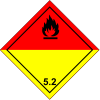
|
Class 5.2 includes all organic peroxides that contain more than 1% active oxygen and more than 1% hydrogen peroxide or more than 0.5% active oxygen and more than 7% hydrogen peroxide. The difference to oxidizing substances assigned to class 5.1 lies in additional explosive reactions or violent fire behavior in the event of a reaction with other flammable substances. Due to their reactivity, organic peroxides must also be stored and transported separately from substances of classes 1, 2.1, 3, 4 and 5.1.
Examples: dibenzoyl peroxide (hardener for polyester resin), methyl ethyl ketone peroxide (hardener for two-component paints). |
Labeling valid since 2007, obsolete hazard symbol ![]() discarded due to similarity with 5.1
discarded due to similarity with 5.1
Class 6 - Toxic Substances
Class 6.1 - Toxic substances

|
The term in Class 6.1 Toxic substances includes substances known from experience or which can be assumed based on animal experiments that, if they are inhaled, swallowed or come into contact with the skin, they can cause damage to health or death in a relatively small amount after a single or brief exposure being able to lead.
Examples: hydrogen cyanide ( hydrogen cyanide ), arsenic , pesticides |
Class 6.2 - Infectious substances
All substances which are known or are expected to contain pathogens, which are known or are expected to cause infectious diseases in animals or humans , are substances of Class 6.2. Infectious substances are substances that are known or can be assumed to contain pathogens . Pathogens are microorganisms (including bacteria, viruses , rickettsiae , parasites, and fungi) or recombined microorganisms (hybrids or mutants) that are known or believed to cause infectious diseases in animals or humans.
Examples: hospital waste, medical samples
Class 7 - Radioactive materials
| All radioactive substances and objects that contain radioactive substances are class 7 substances.
Examples: uranium , plutonium , certain medical instruments, technical test systems for product control.
|
||
| conditions | category | ||
|---|---|---|---|
| Transport code (TI) 7/1 | highest dose rate 7/1 at any point on an external surface | ||
| 0 | not greater than 0.005 mSv / h | I KNOW | |
| greater than 0 but not greater than 1 | greater than 0.005 mSv / h, but not greater than 0.5 mSv / h | II-YELLOW | |
| greater than 1 but not greater than 10 | greater than 0.5 mSv / h, but not greater than 2 mSv / h | III-YELLOW | |
| greater than 10 | greater than 2 mSv / h, but not greater than 10 mSv / h | III-YELLOW | 7/2 |
- ADR Table 2.2.7.8.4 - Categories of packages and overpacks
- 7/2 Is also to be transported under exclusive use
In addition, the criticality safety index (CSI) must be taken into account, which is entered on hazard label 7E. 7/3
This class and its marking is also regulated in the UN Regulations for the Safe Transport of Radioactive Material of the IAEA .
Class 8 - Corrosive substances
The Class 8 comprises all substances, which by chemical action to the skin or mucous membranes with which they come into contact etch . Furthermore, class 8 also includes substances which, when released, can cause damage to other goods or means of transport or destroy them, as well as substances which only form corrosive liquids with water or corrosive vapors or mist with humidity.
Examples: sulfuric acid , caustic soda , hydrochloric acid .
Class 9 - Various Hazardous Substances and Objects
| Class 9 includes all substances and objects that pose a risk during transport and that do not fall under one of the aforementioned classes. This includes other chemical or toxicological hazards, high or low transport temperatures, and physical hazards. |
Examples: dry ice , liquid nitrogen , asbestos , some types of airbags . A new sub-class, class 9A, has been in effect since January 1, 2017. This is limited to the labeling of the transport of lithium batteries .
See also
- Hazardous substance
- Globally harmonized system for the classification and labeling of chemicals
- Hazard symbols for chemicals according to WHMIS , Canada
- Hazard diamond according to NFPA 704, USA
- Number to identify the hazard (hazard number)
- Dangerous Goods Regulations (DGR), the IATA set of rules for the transport of dangerous goods by air
literature
- Michael Schomers : Toxic, caustic, explosive. Rowohlt, Reinbek near Hamburg 1988, ISBN 3-499-12349-5
- Lothar Schott, Manfred Ritter: Fire Brigade Basic Course FwDV 2 . 20th edition. Wenzel-Verlag, Marburg 2018, ISBN 978-3-88293-220-1 .
Web links
- UN Recommendations on the Transport of Dangerous Goods. Model Regulations. United Nations Economic Commission for Europe (UNECE) Transport Division, accessed December 3, 2018 .
- Thurm, Volker; Heinemann, André: Dispatch of medical examination material: Safe and compliant with regulations. Deutsches Ärzteblatt, accessed on July 15, 2013 .
Individual evidence
- ^ Twentieth revised edition (files with track changes). UNECE , accessed December 3, 2018 .
- ↑ a b ADR 2.2.7.6 Determination of the transport index (TI) and the criticality safety index (CSI)
- ↑ IAEA (Ed.): UN Regulations for the Safe Transport of Radioactive Material (= IAEA SAFETY STANDARDS SERIES . No. TS-R-1). 2005 ed. ISBN 92-0-103005-3 , p. 63 ff . (English, pdf , iaea.org [accessed on January 21, 2015]).
- ↑ IAEA (Ed.): UN Regulations for the Safe Transport of Radioactive Material (= IAEA SAFETY STANDARDS SERIES . No. SSR-6). 2012 ed. Vienna 2012, ISBN 978-92-0-133310-0 , p. 67 ff . (English, pdf , iaea.org [accessed on January 21, 2015]).






